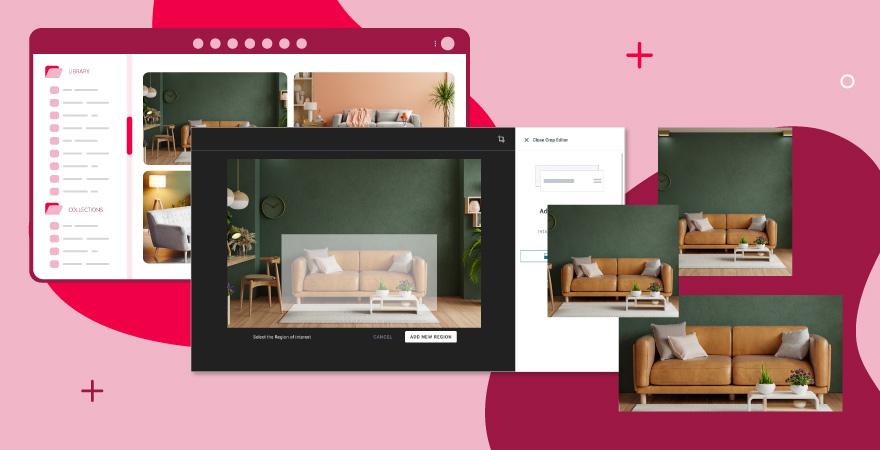The ultimate guide to content distribution with DAM
| September 6, 2024

Most marketers know the frustration of not being able to distribute content quickly enough to achieve their marketing goals, launch product content fast enough, or meet campaign and promotion deadlines.
With so many moving parts, content distribution is challenging. Getting content to the right partners and markets is cumbersome without the right tools to create a cohesive system. Decentralized content controls make it hard to create an on-brand omnichannel experience. And managing media delivery to websites and storefronts without the right automation tools can feel like an endless chore.
So, how can brands overcome these challenges? In this guide, you’ll learn eight key content distribution strategies and how to streamline your content operations.
What is content distribution?
Content distribution is the process of sharing digital content with your audiences through different channels and platforms.
Content distribution includes everything from posting on social media to sending emails and managing website and storefront media. The goal is to get your content to the right people at the right time — at scale and across multiple channels.
Using the best content marketing distribution strategies, you can ensure customers and prospects see, hear, and engage with your brand. Effective content distribution means your audience can easily find, consume, and interact with your content, driving better results for your brand.
Eight content distribution strategies
From adding the right marketing tech stack software to building a community, here are eight key content distribution strategies.
1. Use a DAM platform to distribute content efficiently
A digital asset management (DAM) platform like Canto is a game-changer for efficient content distribution. DAM software centralizes all your brand’s content and includes tools to organize, find, and distribute digital assets very quickly. Dispersed teams in different departments have easy access to all your content, saving time and reducing frustration.
DAM software includes auto-tagging and optical character recognition technologies to organize content on the fly and reduce metadata management. You can also find specific media or people across your entire library using AI-powered search and facial recognition tools.

DAM technology speeds up content delivery to market through automated DAM workflows and integrations with popular tools like CMS software, file storage, and productivity platforms. Some DAM platforms can automatically publish content to various channels and platforms, ensuring that your content reaches the right audience at the right time.
The benefits of digital asset management platforms don’t stop there. DAM platforms also include content controls to scale a consistent, on-brand omnichannel experience across storefronts and websites. What’s more, some platforms provide version control, approval statuses, and expiration dates to control content circulation. Additionally, ensure the DAM software includes digital rights management (DRM) tools to track and manage licensed and copyrighted content at scale.
Finally, you can create and distribute mini-libraries or content collections, known as portals, tailored to specific audiences without needing web development resources.
Interested in what a DAM platform could do for your team? Check out our free Beginner’s Guide to Digital Asset Management.
2. Expand your reach with multi-channel distribution
To maximize your content’s reach and streamline your omnichannel approach, you’ll need a unified content calendar and a DAM platform’s robust controls and tools. Your team will finally be able to distribute, track, and manage all content (even licensed and copyrighted content) while maintaining that cohesive brand experience you’ve been dreaming of.
With a central content calendar and DAM software’s controls and tools, authorized team members can access your self-service, on-brand library and download content in the right sizes and formats without creative oversight. Teams can even automatically deliver media to platforms.
A coordinated approach will speed up time to market, tailor all channel experiences, and ensure your audience receives the right content.
Using a content calendar and DAM together, you can align content distribution across all teams and scale marketing campaigns more effectively.
Pro tip: DAM platforms include download presets so marketing teams can grab content on-demand in the perfect ratios, sizes, and formats without creative oversight.
3. Implement content personalization
Content personalization is crucial to engage your audience effectively. You’ll need to segment your audiences, get the tools to personalize content, and retarget your key audiences.
The first step to personalizing your content distribution is using customer data to segment your audience into suitable groups according to their interests and challenges. Next, use marketing automation tools to deliver personalized content by segment.
Lean into dynamic content technology to take personalization a step further. Trained algorithms can automatically adjust your content’s messaging to align with user behavior and preferences, making sure each individual receives content specifically customized for them.
Additionally, implement retargeting campaigns to re-engage users who have previously shown interest in your content. By reminding them of what caught their eye before, you can drive them back to your site and keep them engaged with your brand.
Pro tip: You can use a DAM platform’s AI tools to find and adapt content quickly.
4. Increase reach with influencers and partnerships
Working with influencers and creating strategic partnerships can significantly boost your content’s reach.
Start by collaborating with individual influencers that have similar values and audiences. Consider forming strategic partnerships with complementary brands or organizations to take your collaborations a step further. By co-creating and co-branding content, you can distribute it to each other’s audiences, expand your exposure, and reach new potential customers.
Pro tip: Use your DAM platform’s self-service portals to deliver customized collections of branded content and optimize influencer marketing campaigns.
5. Rely on data-driven insights
Let your data lead the way to understanding your audiences’ preferences. Detailed reporting and A/B testing will be your best friends as you understand audiences and content performance.
Start by conducting an in-depth audience analysis. Use analytics tools to uncover patterns in audience behaviors, trending interests, and more.
Next, consistently monitor distributed content performance. By tracking which channels and formats are most successful, you can refine your strategy and focus on what works best.
Use A/B testing to try different content types, messaging, and distribution times. By pinpointing the most effective combinations, you can enhance engagement, tailor future strategies, and ensure your content always hits the mark with your audience.
Pro tip: DAM software’s analytics can help you quickly discover top-searched content and keywords and fill content gaps.
6. Embrace automation
Workflow automation tools can streamline repetitive tasks and get content to market quickly. Automated workflows, content scheduling tools, triggered campaigns, and media delivery tools are great examples that enhance marketing ops workflows.
First, automate workflows with your DAM platform to ensure that content processes are smooth and error-free.

Next, automated content scheduling tools are a game changer when it comes to consistently distributing content on time. With them, you can capture your audience’s attention with fresh content without the need for constant manual oversight.
Also, set up triggered campaigns that automatically react to user actions, like subscribing to a newsletter or abandoning a shopping cart. Automated campaigns help you connect with your audience at critical moments during the buyer’s journey.
Finally, use tools like Canto’s Media Publisher to automate content delivery across platforms, sites, and storefronts.
Your web and marketing ops teams will be thankful for the time savings, allowing them to focus on higher-impact work. Plus, your content will always reach the right audience across all your distribution channels.
Pro Tip: Look for a DAM platform that can automate media delivery across platforms to transform your content distribution workflow entirely.
7. Build a community
Creating a strong community around your brand can greatly enhance your content distribution efforts.
Start by establishing community platforms, such as forums, social media groups, or even dedicated platforms where your audience can interact and connect your brand and each other.
Encourage active engagement and interaction within your community. Prompt discussions, seek feedback, and invite user-generated content (UGC) to deepen involvement. UGC is another way to expand brand impact and reach when used correctly and with permission. You’ll also create a loyal group of brand advocates eager to share your content.
Reward your community members with exclusive content or early access to new materials. Offering these perks as a thank-you for their engagement makes them feel valued and keeps them invested in your brand’s success.
Pro Tip: Use upload links to add user-generated content to your DAM library. You can review and approve all content before circulating — and use DRM to ensure the correct permissions are in place before you share anything.
8. Deploy a CDN
Pairing a content delivery network (CDN) and a DAM is a smart move to speed up your content delivery. CDNs improve load times and keep your storefront or websites running smoothly, no matter what.
A CDN spreads your content across multiple servers around the world, so no matter where your audience is, they’ll experience faster load times when accessing your sites and storefronts.
CDNs also help you handle unexpected traffic spikes without any hiccups. So, your site won’t slow down or crash when your content goes viral, a product launch is super successful, or a promotion is reshared and used.
Plus, with a CDN, you get added reliability. If one server has an issue, another picks up the slack, keeping your content accessible and your audience happy.
Pro tip: Choose a DAM with a built-in CDN, like Canto’s Media Publisher, to fetch and display perfectly-sized media in real time on your platforms.
Streamline your content distribution with Canto
Ready to optimize your content distribution and reach more of your target audience efficiently?
Canto is the market-leading digital asset management (DAM) solution. Canto offers powerful tools to streamline omnichannel content operations, accelerate content to all markets, improve brand management, and enhance collaboration and productivity. With Canto, you can ensure your content reaches the right people at the right time, providing a seamless omnichannel experience that drives revenue for your brand.

Canto’s top features include AI Visual Search to quickly find and distribute content, Media Publisher to automate media delivery to your platforms, and unlimited Portals to support rapid market expansion. Additionally, Canto offers automated Workflows, digital Workspaces, integrations with popular tools, and all the comprehensive content controls you need to maintain brand consistency.

Content distribution frequently asked questions
1. How do I select the best distribution channels?
Choose channels where your target audience spends the most time. Consider the type of content you share and match it with the platforms that best support it — like Instagram for visuals or LinkedIn for professional articles. A/B test different channels, track performance, and focus on the ones that drive the most leads and conversions.
2. What tools are best for automating content distribution?
The best tools for automating content distribution include social media schedulers like Buffer or Hootsuite, email marketing platforms like Mailchimp, and workflow automation tools like Zapier. If you manage a lot of digital assets, a DAM platform like Canto with built-in automation features can streamline everything from approvals to publishing across multiple platforms.
3. What is strategic content distribution?
Strategic content distribution involves carefully planning how, where, and when to share your content to reach your target audience effectively. It’s about using the right channels, timing, and formats to ensure your content reaches and engages people. By focusing on the platforms and methods that generate leads, you can maximize the impact of your content.
